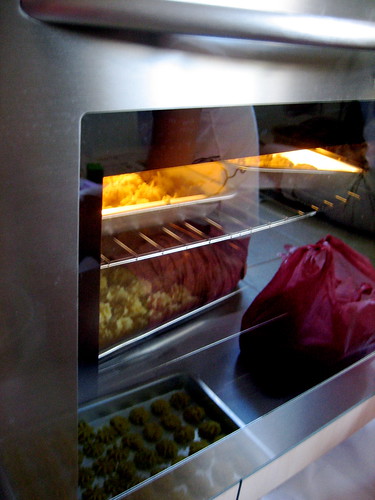Whole Wheat Blender Pancakes
1 cup milk
1 cup uncooked whole wheat
Blend in blender for 4 minutes
Add:
1/2 cup milk
Blend for another 4 minutes
Add:
2 eggs
1/2 cup oil (try using less)
3 teaspoons baking powder
2 tablespoons honey or sugar
½ teaspoon salt
Blend remaining ingredients and cook on hot griddle- batter will be thin.
I also made the baked oatmeal on a weekend night and we enjoyed heating bowls of that up through the week. I made the recipe with whole oats as I planned and it turned out fine (I made 1 and 1/2 times the recipe for a full 9 x 13). I don't think instant oats are needed there. I have also gotten bags of whole wheat English Muffins at the bakery outlets and made lots of egg/cheese (sometimes ham) sandwiches on weekends and wrapped them and froze them to be reheated individually. This can be tricky - when you reheat them sometimes the English Muffin can get tough. So I think letting it thaw first is probably the wisest decision. My mother in law made breakfast burritos for a reunion that we reheated in the oven- they were wrapped in foil. This works really well compared to the microwave. My sister makes a huge pot of steel cut oats with a lot of goodies in it- apples, nuts, etc and she and hubby re-warm it by the bowlful throughout the week. All of these options are great ideas! Just eat breakfast, whatever you prefer to do.
~Here's to Healthy Eating
I also made the baked oatmeal on a weekend night and we enjoyed heating bowls of that up through the week. I made the recipe with whole oats as I planned and it turned out fine (I made 1 and 1/2 times the recipe for a full 9 x 13). I don't think instant oats are needed there. I have also gotten bags of whole wheat English Muffins at the bakery outlets and made lots of egg/cheese (sometimes ham) sandwiches on weekends and wrapped them and froze them to be reheated individually. This can be tricky - when you reheat them sometimes the English Muffin can get tough. So I think letting it thaw first is probably the wisest decision. My mother in law made breakfast burritos for a reunion that we reheated in the oven- they were wrapped in foil. This works really well compared to the microwave. My sister makes a huge pot of steel cut oats with a lot of goodies in it- apples, nuts, etc and she and hubby re-warm it by the bowlful throughout the week. All of these options are great ideas! Just eat breakfast, whatever you prefer to do.
~Here's to Healthy Eating


